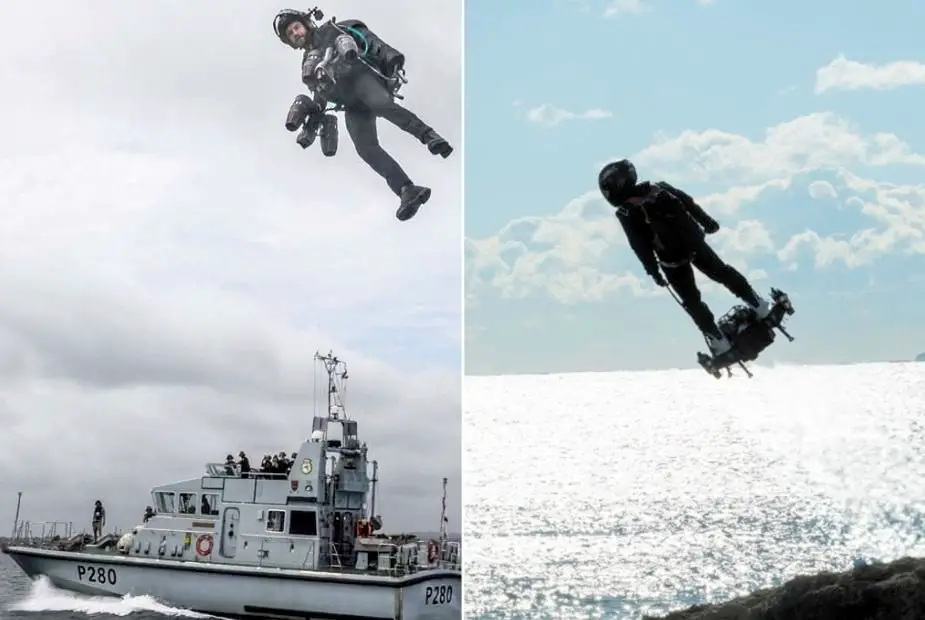One week after the French inventor Franky Zapata failed to cross the Channel (sea sector between France and UK) with his Flyboard Air (he will renew his attempt very soon), the British inventor, test pilot and former Royal Marines reservist Richard Browning has tested his jet-powered bodysuit over the water for the first time.

Richard Browning's Daedalus Mark 1 (left) and Franky Zapata's Flyboard Air (right) (Picture sources: Royal Navy and Franky Zapata)
Browning’s jet suit, named Daedalus Mark 1, uses six tiny jet engines — two mounted on the wearer’s back, with an additional two mounted on each arm — which allow the user to fly through the air in a controlled flight. The suit looks like something out of a Marvel movie: Browning jetted up and down a street, aided by a helmet equipped with a head-up display that provides him with some flight data and fuel usage, the same kind as Zapata’s one.
The first attempt performed by Browning has been successful. He had already demonstrated the potential of his jet-powered suit to the Royal Marines, joined them for amphibious landings and wowed the crowds at Yeovilton at the Fleet Air Arm’s annual show.
This time, a small landing/launchpad was set up on Dasher’s forecastle as he leapt between the boat and two accompanying rib speed boats buzzing around the Solent off Portsmouth Harbour at speeds of up to 20 knots. The trials proved that the suit works over a large body of water and that the pilot can land and take-off with relative ease from boats or ships moving at speed – even with the limited space on the upper deck of a P2000 patrol vessel (let’s remind that Zapata failed to land on the moving boat where he had to take another backpack full of kerosene to complete his Channel crossing; his Flyboard Air’s reliability wasn’t in cause at all). “Being in command of Dasher while the Gravity Industries team were onboard was very different and a new challenge which I was honoured to take on,” said Lieutenant Lauren Webber. “Taking off and landing on the P2000 look so easy, despite the ship travelling at 20 knots.”
The rocketman himself said the work with Dasher proved extremely successful and laid the foundations for further tests at sea from some of the Royal Navy’s larger warships. “It was a pleasure testing our suit with the Royal Navy, offering a unique opportunity to achieve another milestone in the development of our technology,” Richard added.
Commander Milly Ingham, Commander of Portsmouth’s 1st Patrol Boat Squadron – the mother unit for 14 P2000 craft – said working with the jet suit built on the RN’s long-standing tradition of being at the cutting edge of technological developments from the days of steam through to the world’s most advanced battleship, Dreadnought, and ASDIC – better known today as sonar – which was key to defeating the U-boat in World War 2.
Franky Zapata’s Flyboard Air can lose one engine and still continue the mission. If two engines quit, the Flyboard Air will make a controlled descent. Independent engine electronics means any possible electronic failure can only affect one engine at a time and the Flyboard Air can still safely fly. Quick-release boots mean the pilot can quickly let the Flyboard Air go away in case of an emergency water landing. There are triple-redundant flight controls: two wired systems, plus one wireless backup system. The auto-hover mode allows the pilot to maintain a steady altitude without having to manage the throttle. The embedded stabilization is independent of flight controls. Isolated turbines with improved cooling and lubrication increase jet engine reliability and lifetime. Each engine is independently supplied with kerosene. The status indications provided via head-up display informs the pilot of the engine status, fuel levels, altitude and speed.
To conclude this overview of both systems, let’s mention that the French one leaves the hands free, while the British one leaves the feet free. Hence, different constraints in shaping their operational use.















